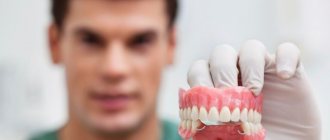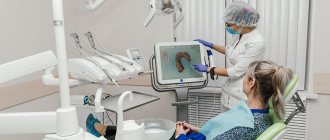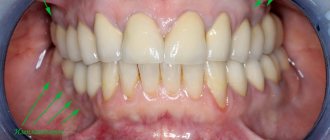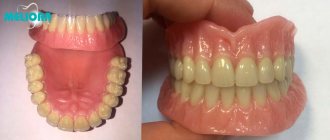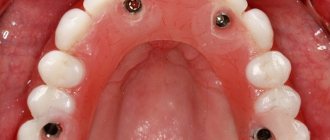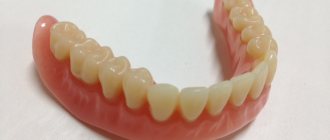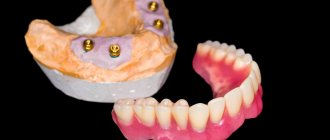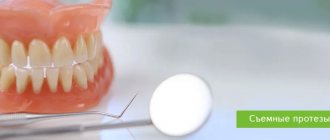Dentistry today works real miracles. Despite this, keeping teeth intact in old age is not so easy. As a rule, older people need prosthetics. At the same time, it is important to choose the right orthopedic design, since at the moment the choice of prostheses is huge. Each material and product has both its advantages and disadvantages. Therefore, it is necessary to proceed from the individual characteristics of the patient, as well as from the clinical picture of his oral cavity.
The need for prosthetics for partial edentia
The diagnosis of “partial adentia” means that a person does not have 1-10 teeth on one row of teeth or two at once. Moreover, they are completely lost, i.e. along with the root. This state of affairs, unless, of course, you wear prosthetics and walk with defects in a row, will immediately lead to a set of problems. Firstly, the aesthetics of the smile will decrease. Secondly, it will be problematic to chew food, and this entails gastrointestinal diseases and a general weakening of the body. Thirdly, in the place of the former roots, the bone tissue of the jaw begins to dissolve or decrease (this occurs due to atrophy). After a few months or years, the gum level will drop significantly, making some types of prosthetics impossible.
Therefore, the earlier prosthetics are performed after tooth loss, the more advantages for the person himself. And this is not only a beautiful smile, but also better health.
When to visit a specialist
You should take advantage of the progressive possibilities of orthopedics (dentistry) in the following situations:
- the crown is very badly destroyed due to caries and it is not possible to restore it with filling material;
- the roots have completely collapsed and cannot serve as support for a future external structure;
- Dangerous pathological processes and necrosis have been identified in hard tissues;
- there are diseases that have caused a change in the shape of the crown part of the molars, incisors, and canines;
- advanced periodontal disease was detected.
Also, the help of an orthopedic dentist will be needed if there are chips, cracks, deep scratches, or individual units are positioned incorrectly in relation to their “neighbors.”
The doctor is responsible for:
- making the correct diagnosis;
- carrying out preparatory activities, preparing for planned therapy;
- choosing the optimal prosthetic method;
- installation of removable/fixed dentures.
Classification of partial dentures
If possible, removal and according to the structure
Prosthetic structures for partial absence of teeth are either fixed or removable[1]. Fixed are dental bridges that are fixed to the remaining teeth or their roots, or to implants. Bridges consist only of crowns joined together. The central ones mask the defect, and the outer ones are fixed on supports. If the natural gum has noticeably “gone” due to atrophic processes, then the dental bridge is supplemented with a small area of acrylic gum.
Removable ones are divided into “true” removable ones - which are removed from the mouth several times a day, and conditionally removable ones - they can be worn for weeks without removal. They consist of the following components:
- prosthetic base: made of elastic or not very flexible (rigid) synthetic materials. It simultaneously imitates gums, part of the palate, serves as a support for artificial crowns or teeth, fasteners, a reinforcing frame,
- artificial teeth: made of plastic, metal, metal-plastic, ceramics, ceramic composite, metal ceramics, etc.,
- fastenings (elements for fixation): in partial ones, the fasteners are represented by clasps (hooks), attachments (clasps), and telescopic crowns. This differs from complete removable dentures with suction cups,
- metal arch (clasp): placed in clasp dentures. It strengthens the structure and better distributes chewing pressure.
When teeth are missing on only one side of the jaw, the orthodontist may recommend a one-sided denture. The bridge structure will not be removable. And removable partial ones, for example, “butterflies” or immediate dentures for 1-2 teeth, and systems on dental implants.
Depending on the material
Most often, partial dentures are classified by material. Thus, the following types of removable orthopedic structures are determined for partial absence of teeth (but some are also suitable for a completely toothless jaw):
- acrylic, incl. partial removable dentures made of acrylic plastic with the addition of diamond chips,
- Acry-Free (“Acry-free”) does not contain an allergenic monomer,
- nylon,
- polyurethane,
- with a metal arch at the base (clasp), splinting clasps with massive metal extensions or rings for fixing mobile teeth,
- Quattro Ti (“Quadrotti”) made of Dental D material,
- sandwich prosthesis: made of polymer materials connected in a special way. But, as a rule, this structure is placed on the entire row of teeth at once, and 1-2 preserved and not loose teeth are enough to attach it.
Such a popular type of removable structures as plate dentures can be not only complete, but also partial. They are made from acrylic, nylon, polyurethane. The very name “plate” implies that the prosthetic base is represented by a solid or monolithic plate of material.
Methods of fastening partial structures
We have already mentioned the fastening of orthopedic structures, let’s take a closer look at how partial removable dentures are fastened:
- on synthetic or metal hook clasps: the clasps extend from the base and cover the supporting teeth. Hooks, especially metal ones, can be noticeable when you open your mouth,
- on attachments (lock fastening): clasp, sandwich dentures, and some types of bridges are made on locks. Here, one part of the fastening is in the prosthesis, and the second in the supporting tooth. During installation, the 2 components are connected to each other - this fastening is not noticeable from the outside,
- on telescopic crowns: this mount is mainly used in clasp systems. The principle is that one prosthetic crown is placed on another, slightly smaller in size, which is installed on the abutment tooth. The fastening is reliable and aesthetically pleasing, but difficult to manufacture.
Fixed bridge structures on natural teeth and conditionally removable bridges on implants are fixed in the following ways:
- on cement: this is how fixed bridges are attached,
- on screws (used only on implants): the method is used to fix crowns and bridge structures. The peculiarity of screw fixation is that the screws can be unscrewed (this is done by a doctor). The prosthesis itself is not damaged by this and can be fixed again. With cement fixation, the structure often has to be sawed to remove,
- on spherical abutments, on a bar, on equatorial abutments (on implants): these options are used only for removable implants,
- on an adhesive composition (special glue): this is how adhesive or Maryland bridges are fixed - temporary products for replenishing 1-2 teeth.
Adjustment period
After the procedure for installing dentures, the specialist gives the patient certain recommendations to reduce the time of getting used to them. This is a very individual moment, because some people get used to it in a couple of months, while others may need at least one year.
Even if you choose from the best removable appliances, you need to understand that they are all a foreign object in your mouth, so it is natural that some adaptation is required to get used to it. Sometimes it comes to the point that some patients try to get rid of these structures on their own, which cannot be done (especially in the case of conditionally removable dentures).
Differences between designs for the upper and lower jaw
A partial removable denture for the upper jaw differs from a similar design for the lower jaw in that when fixed to the upper teeth, it includes a palatal bridge (for clasp ones, for Quadrotti) or a more massive artificial palate. There is, of course, no palate on the lower jaw. And if a large number of teeth are restored here at once, then the base is supplemented with a large volume of artificial gum.
The most compact sizes are for partial removable and non-removable implants (here an artificial palate is not needed at all), for bridges, and for removable new generation without palate - sandwich dentures.
Indications and contraindications
The indication for installation is the absence of 1-2 or more teeth in the jaw, but not all at once. Removable partial dentures are suitable for children, the elderly, pregnant women, people with allergies, and not just patients in good health.
Contraindications vary from person to person. For example, if you are allergic to acrylic, such a prosthesis will not be installed, but you can choose a different material. Or, if in preparation for prosthetics it is necessary to remove nerves from supporting teeth with anesthesia (a “freezing” injection) or install dental implants, then childhood, heart problems, and pregnancy may be contraindications.
Read on the topic: indications and contraindications for dental implantation – when implants can be placed and when they cannot.
What problems can be solved with dental orthopedics?
With the help of dental orthopedics, the following problems can be solved:
- Replace missing units with a prosthesis.
- Restore a severely damaged tooth
- Restore chewing function in complete absence of teeth.
- Prevent jaw tissue atrophy.
Dental orthopedics is designed to restore lost or damaged units. If only 1-3 teeth are missing, experts recommend installing non-removable dental products. If more than 3 teeth are missing, a clasp denture can be installed. Acrylic or nylon products are most often installed in the absence of a large number of teeth; they will cost much less, but in terms of comfort and aesthetic indicators they will be inferior to more expensive analogues.
Benefits of Partial Dentures
The benefits of removable partial dentures depend on their type. Let's take a closer look at the positive qualities:
- a large number of indications: among the removable ones, you can choose an orthopedic design for any patient,
- the best fixation (reliable, durable): partial on implants. Clasp crowns with attachments or telescopic crowns are not as reliable, but they are still better than classic removable ones with hooks.
- sufficiently high smile aesthetics,
- fast production: it takes 2-10 days, depending on the workload of the laboratory.
Preparation for installation of prostheses and restorative procedures
Before installing any type of prosthesis, the doctor carries out preparatory measures. During them:
- Treats caries. All carious cavities must be closed.
- Provides therapy for detected oral diseases. It is important that the gums are in satisfactory condition and the patient is not bothered by pain.
- Eliminates anomalies. It happens that before receiving prosthetics, a person is sent for a consultation with an orthodontist so that the existing curvatures can be removed.
- Provides professional hygiene. During this procedure, it removes soft plaque and hardened stone. This measure is preventative - it eliminates gum inflammation in the future and promotes the speedy healing of implants.
- Prepares supports for crowns. To do this, the teeth are ground, treated and the canals are filled.
Only after preparation can you proceed to prosthetics and implantation.
What are the disadvantages?
As for the disadvantages, they will also depend on the type of product. For example, classic removable ones with clasp fixation may have noticeable hooks, i.e. the person will be embarrassed to smile. Such structures can also injure supporting teeth, and they distribute the chewing load worse than others, so the bone tissue under them atrophies more strongly. Due to ongoing atrophy, the systems become uncomfortable over time, become dislodged during chewing, rub, and cause pain. You have to often visit an orthopedist to reline the product and use special creams to adhere it to the gums.
“Removable dentures are, of course, still a torment. It is very inconvenient to chew with them, they all tend to fall out, and the teeth are only for beauty. I suffered with them for a year, then I installed the clasp. It seems better, but it’s also not ideal, you have to glue it with Core every day.”
Marina T., review from the woman.ru forum
If we consider the disadvantages of materials, then flexible nylon products are overly soft, stretch when worn, and do not return to their original sizes. Plastics have a porous structure and absorb foreign odors, pigments - if they are not properly cared for, the materials quickly lose their aesthetics and begin to emit an unpleasant odor.
Stages of manufacturing structures
Before the fabrication of partial removable and fixed dentures, the patient undergoes examination and preparation. It is necessary to do an X-ray or computed tomography of the jaw, and treat sore teeth and gums. Then the dentist makes impressions - takes impressions of the dentition. Dynamic bite parameters are also taken so that the future prosthesis is not only beautiful, but also comfortable and functional. Impressions and other data are sent to the dental laboratory.
In the laboratory, a wax-up model of the partial orthopedic structure is first made. Next, it is tried on for the patient, modified if necessary, and tried on again. After which a permanent prosthesis is made.
Basic rules of use
By following these recommendations, you will significantly reduce the period of adaptation:
- When putting on prostheses, various reactions of the body are possible. To stop an attack of nausea, drink tea or eat candy.
- Make a change to your usual menu. Food should be crushed and not rough. Any types of viscous products that can harm not only healthy teeth, but also the structure itself are prohibited.
- We recommend that you leave your dentures on at night to speed up the adaptation period.
- Hygiene should be about more than just regular cleaning. You can purchase mouthwash and other similar products.
- Use special pastes and creams for additional fixation.
- When using completely removable dentures, the patient's diction is distorted.
To remedy the situation, we recommend that you read aloud more often.
Features of wearing and care
Classic removable dentures should be removed after each meal and washed in water, cleaned of adhered pieces and soft deposits. Clasp and removable ones on implants can be removed once every 2-3 weeks to thoroughly clean. But even here, after each meal you need to rinse your mouth or use an irrigator.
You should not chew very hard foods - candies, seeds, seeds, nut shells. It is also better to exclude toffees, chewing gum, and toffees. The structure may break or lose its fixation. To ensure that artificial teeth look like new for a long time and do not cause discomfort, you should visit an orthopedic dentist 1-2 times a year for professional cleaning and minor repairs, if necessary.
How else to care for dentures?
In addition to the standard cleaning procedure, dentures require additional care. It is necessary to use a special disinfectant, which is easy to find in a regular pharmacy (they come in different forms). They need to be dissolved in water, and then the prosthesis is lowered into it. 30 minutes is enough for disinfection.
No matter how high-quality your prosthesis is, you should avoid any contact with aggressive chemicals. It is also necessary to exclude any mechanical impact (cleaning is best done over a soft towel to prevent breakage in the event of a fall). If you find any crack or small chip, you should immediately contact a specialist without making any attempts to repair anything.
